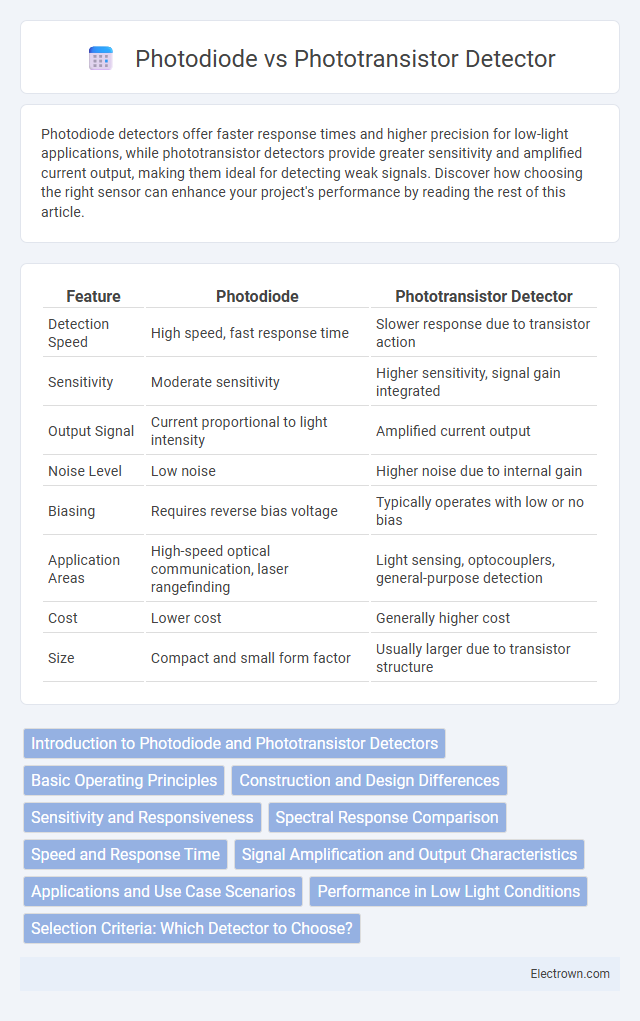Photodiode detectors offer faster response times and higher precision for low-light applications, while phototransistor detectors provide greater sensitivity and amplified current output, making them ideal for detecting weak signals. Discover how choosing the right sensor can enhance your project's performance by reading the rest of this article.
Table of Comparison
| Feature | Photodiode | Phototransistor Detector |
|---|---|---|
| Detection Speed | High speed, fast response time | Slower response due to transistor action |
| Sensitivity | Moderate sensitivity | Higher sensitivity, signal gain integrated |
| Output Signal | Current proportional to light intensity | Amplified current output |
| Noise Level | Low noise | Higher noise due to internal gain |
| Biasing | Requires reverse bias voltage | Typically operates with low or no bias |
| Application Areas | High-speed optical communication, laser rangefinding | Light sensing, optocouplers, general-purpose detection |
| Cost | Lower cost | Generally higher cost |
| Size | Compact and small form factor | Usually larger due to transistor structure |
Introduction to Photodiode and Phototransistor Detectors
Photodiode and phototransistor detectors are widely used semiconductor devices for converting light into electrical signals. Photodiodes offer fast response times and linearity, making them ideal for precise light measurement in optical communication and sensing applications. Your choice between them depends on whether you need higher sensitivity from the phototransistor or quicker, more accurate detection from the photodiode.
Basic Operating Principles
Photodiodes operate by converting light into current through the photovoltaic effect, generating electron-hole pairs when photons are absorbed, resulting in a linear and fast response ideal for precise light detection. Phototransistors combine the principles of photodiodes and transistors, where incident light controls the base current, amplifying the output signal and providing higher sensitivity but slower response times. The fundamental difference lies in the photodiode's direct photoelectric conversion versus the phototransistor's photogenerated current amplification mechanism.
Construction and Design Differences
Photodiodes consist of a simple p-n junction designed to convert light into current with fast response times and high linearity, while phototransistors combine a photodiode and a transistor to amplify the photocurrent, resulting in higher sensitivity but slower response. Phototransistors have a more complex construction with an additional base region to allow current gain, whereas photodiodes operate as a single-junction device with minimal internal amplification. The structural differences affect their performance in applications, with photodiodes favored for precision and speed, and phototransistors preferred for detecting low light levels due to intrinsic signal amplification.
Sensitivity and Responsiveness
Photodiodes offer high responsiveness with fast response times ideal for detecting rapid light changes, while phototransistors provide greater sensitivity, amplifying weak light signals for better detection in low-light conditions. Your choice depends on whether speed or sensitivity is critical for your application, as photodiodes excel in precision timing and phototransistors perform well in signal amplification. Understanding the trade-off between responsiveness and sensitivity ensures optimal detector performance in optical sensing tasks.
Spectral Response Comparison
Photodiodes typically exhibit a broader spectral response, ranging from ultraviolet (200 nm) to near-infrared (1100 nm), making them suitable for applications requiring wide wavelength detection. Phototransistors, however, generally have a narrower spectral response, often centered around the visible spectrum (400 nm to 700 nm), with peak sensitivity near 600 nm due to their structural design. The choice between photodiode and phototransistor detectors hinges on the specific spectral sensitivity requirements and response speed of the intended application.
Speed and Response Time
Photodiodes offer faster response times, typically in the nanosecond range, making them ideal for high-speed applications requiring rapid light detection. Phototransistors, while more sensitive, generally have slower response times due to their internal gain mechanism, often in the microsecond range. Your choice between these detectors depends on whether speed or sensitivity is the priority for your optical system's performance.
Signal Amplification and Output Characteristics
Phototransistor detectors provide inherent signal amplification due to the transistor action, resulting in higher output current and greater sensitivity than photodiodes. Photodiodes generate current proportional to light intensity with faster response times but typically require external amplification to achieve comparable signal levels. Your choice depends on whether higher gain with slower response or faster response with lower gain suits your application's output characteristics better.
Applications and Use Case Scenarios
Photodiode detectors excel in fast response time and linearity, making them ideal for high-speed optical communication, medical instrumentation, and precise light measurement applications. Phototransistor detectors offer higher sensitivity and gain, suited for low-light environments such as remote control receivers, optical switches, and light detection in consumer electronics. Choosing between photodiodes and phototransistors depends on the required sensitivity, speed, and application-specific conditions for optimal performance.
Performance in Low Light Conditions
Phototransistors offer higher sensitivity and better amplification in low light conditions compared to photodiodes, making them more suitable for detecting weak light signals. Photodiodes respond faster and have lower noise levels but generally require additional amplification to perform well in dim environments. Your choice depends on balancing the need for speed and noise performance against sensitivity requirements in low-light applications.
Selection Criteria: Which Detector to Choose?
Photodiodes offer fast response times and high linearity, making them ideal for applications requiring precise light measurement and high-speed detection. Phototransistors provide greater sensitivity and amplification, suitable for detecting low light levels but with slower response and potential nonlinearity. You should choose a photodiode for accuracy and speed, while a phototransistor is better when sensitivity to weak signals is paramount.
Photodiode vs Phototransistor Detector Infographic

 electrown.com
electrown.com